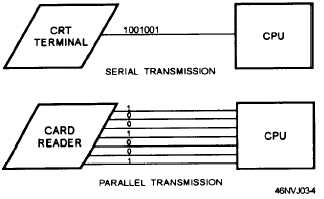Data Transmission Methods
Data may be transmitted over a channel in one of
two ways, either in the serial or the parallel mode.
SERIAL MODE.—In serial mode (transmission),
three wires are required: one to transmit data, one to
receive data, and one for a ground. The data is sent or
received in the form of bits, one alter another in a series,
as shown in figure 3-2. This type of transmission is
desirable whenever a computer system is linked to
outside peripherals over a long distance, such as remote
terminals.
PARALLEL MODE.—In parallel mode
(transmission), the data bits are all sent or received
simultaneously. Parallel transmission requires nine or
ten wires to connect the computer to the peripheral
device (fig. 3-2). Seven or eight lines are required for
data bits, one or two lines for “handshake” purposes,
and one line for a ground. The handshaking signals
communicate information back and forth between the
peripheral devices and the computer. This information
lets the peripheral know when the computer is ready to
accept another character and vice versa. This type of
transmission is useful for fast data transfer. The
principal drawback is the computer must not be located
relatively close to the peripheral device.
MODEMS
When data is transmitted directly to the computer
over long distances, it is necessary to add two other
devices, one at each end. These devices are called
modems. The word modem is an acronym for
MOdulator-DEModulator. A modem converts the
digital signal produced by a computer to asuitable audio
signal for transmission over communication lines (I/O
Figure 3-2.—Serial and parallel data transmission.
channels). The modem at the other end of the line
reconverts the audio signal back to a digital signal
before sending it to the CPU. If this conversion (digital
to audio) was not carried out, the digital signal would
degenerate during transmission and become garbled.
Modems are commonly used to send and receive data
over telephone lines, making them a very valuable tool
for imaging facilities.
COMPUTER SYSTEM SOFTWARE
Software plays an important role in computer
operations. Without software, a computer could not
perform simple addition. It is the software that makes
everything happen. "Software" may be defined as all
the stored programs and routines (operating aids)
required to use the capabilities of a computer system
fully. Basically, two types of software are used:
systems software and applications software.
SYSTEMS SOFTWARE
Systems software is often referred to as systems
programs. Systems software consists of supervisory
and support programs designed to coordinate the
capabilities of the computer itself. These include
programs, such as operating systems, assemblers and
compilers, and utilities.
Operating Systems
An operating system is a collection of many
programs used by the computer to manage resources
and operations. These programs control the execution
of other programs. They schedule, assign resources,
monitor, and control the work of the computer. These
actions are carried out without human intervention.
Assemblers and Compilers
Both assemblers and compilers are language
translators. They are designed for specific machines
and specific languages. They translate computer
programs written in programming language into
machine language. A language translator for an
assembly language is called an assembler program.
Most high-level language translators are compiler
programs. These translators are designed to convert
artificial languages used by programmers into
machine-usable code after it is entered into the
computer.
3-6



